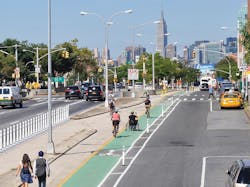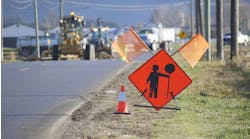If we and our cars were both on Facebook, our relationship status would be “It’s complicated.” Like all relationships, it involves compromises and trade-offs. But we are still together—humans and automobiles—after more than 100 years. How did we do it?
To make this relationship last so long, we have shared a lot of personal information to gain more public safety and greater personal convenience on our roads. Looking back on how this happened can help us forecast what needs to come next. Can we continue this relationship based on sharing information for more safety and convenience as we share the road with connected and autonomous vehicles?
In the beginning
Beginning in 1901, New York State required vehicle license plates. Initially they were to be the owner’s initials and a number, homemade, and affixed to the rear of the vehicle. This original vanity plate did not last long. Owners did not always use their initials, or anyone’s. What the state expected to be personal information ended up being random information. In 1910, the state began manufacturing license plates for auto owners to place on their vehicles to eliminate any nonsense from owners trying to disguise their ownership. This formalized the exchange of personal information for the license plate and permission to use their vehicle on public roads.
Also in 1910, New York required chauffeurs to be licensed. Prior to then, they had to wear badges identifying themselves. That was not sufficient for the safety of their passengers and others. A more detailed system for greater accountability was developed for these professional drivers. They had to provide a lot of information about their appearance, and their photo had to be included on the license so their identities could be confirmed. This must have been received as a good idea, because beginning in 1917 vehicle operator licenses were required for all New York State drivers. No photo or descriptive information was then required for people driving themselves, just their name and address.
From then, another 17 years would pass until the state took the next obvious step to test drivers prior to issuing them a license to operate a passenger vehicle. This “intrusive” requirement began a practice continued today. Potential drivers must demonstrate a minimum level of competency before acquiring New York State’s permission to drive on public roads.
In New York State there were not many changes to passenger car driver licenses for a long time. Over the years, drivers provided only a little more identifying information about their height, eye color and need to wear glasses. In 1984, the state significantly increased its requirement for information on its driver’s license. It added a color photo and fraud protection features in the license itself. Both of these measures made the license more difficult to counterfeit. It provided more assurance that only documented and tested drivers were operating vehicles. It also supported the state’s increase in its alcoholic beverage drinking age to 21, which may have been a significant justification for the change.
Similar activities occurred at similar times in other states. They improved public safety on their roads each time vehicle owners and drivers provided more information about their vehicles, about themselves, and even about their skill to proficiently operate a motor vehicle. They had a basis to create and enforce standards about the safe operation of vehicles on public roads. The compliance of the vehicle owners and drivers demonstrates their investment in the evolving shared information system to manage the use of public roads. It also demonstrated that sharing this information was a reasonable intrusion for the resulting safety benefits.
The E-ZPass toll tag allowed the system to log drivers’ locations with the time of day every time the tag was used. As a result, E-ZPass increased public safety.
More technology
In 1993 the Thruway Authority of New York State introduced E-ZPass. Drivers who joined shared their financial information in addition to their personal data to pay their tolls in advance for more convenience while driving. They did not have to worry about having cash or exact change while driving. A further advantage, the E-ZPass lanes had shorter lines than the cash paying lanes while adoption grew. In addition to drivers gaining greater convenience, authorized law enforcement agencies could access the system’s information as well. The toll tag allowed the E-ZPass system to log drivers’ locations with the time of day every time the tag was used. As a result, E-ZPass also increased public safety, as did the measures previously implemented.
For years, E-ZPass’ location-logging scared away many people who refused the convenience to maintain more privacy and avoid questions from nosy family members examining paper E-ZPass bills sent to their homes. That may be another reason why cash toll lanes had long lines for many years. That has been eliminated in New York State with the recently completed replacement of toll booths. License plate scanners at toll locations now capture personal and travel information even when cars do not have toll tags.
Credit cards were introduced in 2000 as a payment option in some New York City taxi cabs. Using credit cards in cabs also allows passengers to share their financial and personal information for greater convenience. Previously, passengers traveled anonymously by paying cash. (Those nosy family members would now have credit card bills to examine for travel information, too.)
The pace of change in the 21st century has moved more quickly than it had for most of the 20th century. In 2010 Uber launched in San Francisco. In 2011 Uber began operations in New York City. In 2013 the city officially recognized Uber, Lyft and other ride-hailing app services. Their use requires customers to share more personal information for greater convenience and safety.
In the ride-hailing app model, customers share their personal and financial info, and they also share their origin and destination info, to hire a car with their smartphones. They gain the convenience of quickly requesting a ride without planning and without having to attract the attention of taxi cabs that may pass by their location. Customers also receive increased safety and reliability.
Ride-hail app customers and the company know the driver in advance. This increases accountability and equity. It makes it less likely drivers will refuse to drive particular customers based on personally profiling them or their origins and destinations. The ride-hail app model also provides more safety for drivers. They have more information in advance, and they know who they are picking up. Whether customers have been exercising their over-21 party privileges, drivers only learn when they pick them up. The companies have rating systems for both sides so that drivers and passengers can avoid future problems. Ride-hail app customers and drivers have a surer and safer ride with the increased accountability offered by exchanging their identifying info in advance.
Drivers who joined E-ZPass shared their financial information and personal data for more convenience while driving in New York State.
And next?
How will this look in the future? How will important information sharing to achieve more public safety be achieved in the anticipated future world of shared, autonomous vehicles?
We do not know exactly when the robot cars will arrive for retail purchase and public customer use, though those with vested interest wish to assure us it will only be a matter of a few years’ time. Yet, many well-regarded researchers, including those at the auto manufacturers, believe fully automated cars will not be ready soon, if ever. This makes the fully automated vehicle future uncertain.
We are pretty sure that except for the very wealthy, we will share and not personally own autonomous cars. We can reasonably predict that all of their onboard technology will make them rather expensive, putting their purchase out of reach for most people. They are likely to be owned mostly by for-hire vehicle fleets. We also can reasonably predict that the fleets will require that customers share all of the personal, financial, and travel information they have provided over the past 100 years to drive and own vehicles, in order to ride in for-hire vehicles. The automated vehicle fleet companies will not allow us to ride in their robot cars anonymously.
For over 100 years, we have sacrificed our privacy. We have made ourselves more transparent and even risked that our data might be used in unauthorized ways, all to improve safety and for our own convenience. How about the autonomous vehicles? What information should they share to make us safer? Should the autonomous vehicle companies share some of their data? Should they share their safety data to allow us to evaluate their readiness for operation on public roads?
So far, they have not shared much. There are many important questions that should be answered before welcoming them on public roads, such as:
- How will we know that their robot cars operate safely among people-driven cars?
- How will we know that their robot cars operate more safely than the people-driven cars, as they claim?
- How will we know that their security systems will keep our data private and their systems safe from imposters and hackers?
We have learned a lot lately that many of our leading tech firms and financial companies have been hacked and have exposed our private data with little consequence. We also have learned that imposters have infiltrated these companies’ systems and may have influenced the last presidential election, also with little consequence. We also know that in the U.S. some of the same companies that want to put their driverless cars on our public roads have been recalling more vehicles each year than they have sold. Industry’s past record on security and vehicle safety has been, at best, mixed.
We need the autonomous vehicle companies to share information. We need them to share testing, performance and security information—now, not when they are good and ready. We need a large community of engineering, safety, and security experts to confirm the claims of the autonomous vehicle companies that their products are safe and secure, and that they are, in fact, doing what the companies are claiming they are able to do. That will allow us to confirm that our data sharing will be traded, as before, for increased safety as well as additional convenience.
Sharing for safety, that has been the deal for over a century. And the robot car companies need to get on board.



